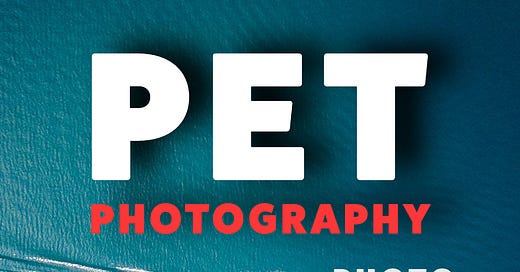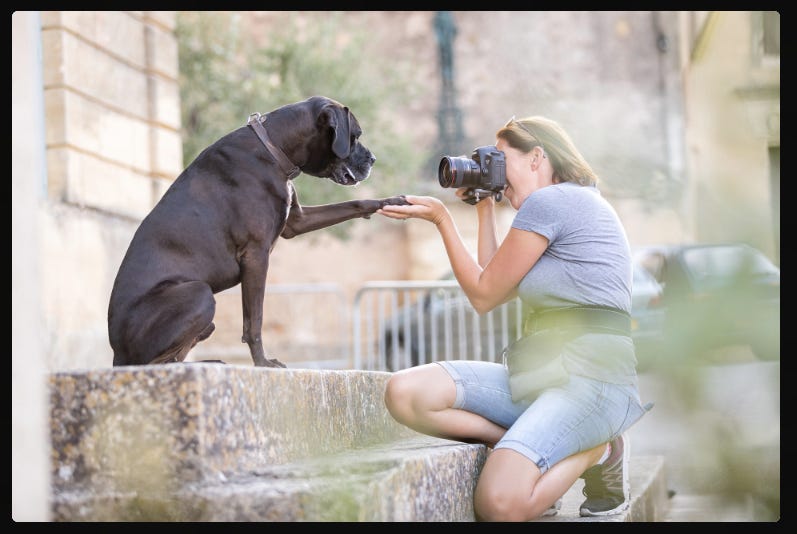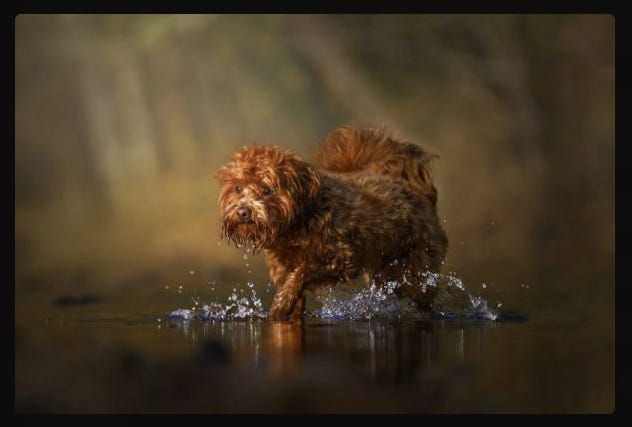[Last updated: Dec 13, 2024]
Welcome to the enchanting world of pet photography!
This comprehensive guide will transform you into a skilled pet photographer, ready to immortalize every adorable moment of your furry companions.
Understanding Pet Behavior: The Key to Perfect Shots
Mastering pet photography begins with understanding your subjects.
Dogs and cats have unique behavioral patterns that significantly impact photo sessions.
Dogs: Often energetic and responsive to commands
Cats: Generally more independent and unpredictable
Anticipating their actions will help you capture those priceless, spontaneous moments that make pet photos special.
Recent research published in the journal Animals found that dogs can recognize human faces in photographs, which has implications for pet photography.
Dr. Kun Guo, the lead researcher, states:
"Our study provides the first evidence that dogs are able to recognize human faces in photographs. This suggests that dogs may be more attuned to human facial cues than previously thought, which can be leveraged in pet photography sessions."
For example, a photographer might use a squeaky toy to capture a dog's attention, resulting in an alert, engaged expression that showcases the pet's personality.
Essential Accessories for Pet Photography
Treat Pouch
A hands-free treat pouch like the Ruffwear Treat Trader allows you to quickly reward and engage pets during photo sessions.
Squeaky Toys
The Outward Hound Invincibles Squeaky Dog Toy is great for capturing a dog's attention and creating engaging expressions.
Collapsible Reflector
The Neewer 43-inch 5-in-1 Collapsible Multi-Disc Light Reflector helps control lighting and add catchlights to pets' eyes.
Composition Techniques: Level Up Your Pet Photos
Creating captivating pet photographs goes beyond simply pointing your camera.
Set up these techniques to make your images stand out:
Rule of Thirds: Place your pet off-center for a more dynamic composition
Leading Lines: Use natural elements to draw attention to your furry subject
Framing: Incorporate environmental elements to frame your pet
Experiment with various angles and perspectives to add depth and interest to your shots.
A study published in the Journal of Visual Communication found that images following the rule of thirds were perceived as more aesthetically pleasing by viewers.
This underscores the importance of composition in pet photography.
Consider a scenario where a cat is sitting on a windowsill.
Placing the cat in the left third of the frame and allowing the window's view to occupy the remaining space could create a striking image.
It not only focuses the attention on the cat, but also tells a story about its environment.
To further improve your pet photography skills, explore my Ultimate Photography Guide for Beginners.
Studio Backdrop Techniques
Setting Up Your Space
Position backdrops at least 3 feet from the wall to avoid casting shadows
Ensure the backdrop is pulled taut to eliminate wrinkles and creases
Create depth by leaving adequate space between subject and backdrop
Backdrop Selection
Use solid colors that complement pet fur colors
Avoid busy patterns that can distract from the subject
Consider seamless paper for clean, professional results
Positioning Tips
Place pets at least 4 feet from the backdrop to minimize shadows
Use markers or mats to help pets understand where to sit
Position main lights at 45-degree angles to minimize backdrop shadows
Common Backdrop Challenges
Keep spare backdrops ready for accidents or mishaps
Use weights to secure backdrop stands when working with active pets
Consider using washable backdrops for easy maintenance
Budget-Friendly Lighting Solutions
The following lighting setups offer excellent value for pet photography studios:
Basic One-Light Setup
Godox AD200 flash with softbox
Perfect for indoor pet portraits, typically only needs 1/4 power for most shots
Compact LED light ideal for fill lighting, priced around $45
Includes two lights with adjustable tripod stands and color filters
Continuous Lighting Options
Features adjustable color temperature (2700-6500K) and brightness control, ideal for keeping pets calm during shoots
Two-softbox setup with adjustable angles, perfect for portrait-style pet photos
NiceVeedi 2-Pack LED Video Light Kit
Compact solution with adjustable brightness and color temperature
Key Setup Tips
Position main light at 45-degree angle to your pet
Use reflectors to fill shadows without additional lights
Keep lights at 4-5 feet height for optimal pet illumination
Pro Tip: Choose continuous LED lighting over flash for pet photography, as it won't startle animals and creates a more comfortable environment
Lighting and Exposure: Illuminate Your Pet's Best Features
Lighting is fundamental in pet photography.
While natural light often yields the best results, mastering artificial lighting can overcome challenging conditions.
💡Pro Tip: Use reflectors or diffusers to soften harsh shadows and create a flattering glow on your pet's fur.
According to a recent survey by The Influence Agency, proper lighting was cited as the most important factor in creating high-quality photographs by 78% of professional photographers.
When photographing a dark-furred dog outdoors, a photographer might use a reflector to bounce light onto the pet's face, revealing details in the fur and capturing the sparkle in its eyes.
For more advanced techniques, read my guide on Master HDR Photography: Capture Stunning High Dynamic Range.
Focusing Strategies: Capture Tack-Sharp Images
Achieving sharp focus is essential in pet photography.
Here's how to nail it:
Master autofocus modes (single-point, dynamic area, group area)
Customize settings based on your pet's movement patterns
Utilize continuous shooting mode to capture multiple shots quickly
Professional pet photographer Emily Reeves advises:
"For active pets, I recommend using a shutter speed of at least 1/500 sec to freeze motion and ensure sharp images."
Imagine capturing an energetic small dog mid-jump.
Using a fast shutter speed of 1/800 sec could freeze the action, capturing every detail from outstretched paws to a determined expression.
Learn more about camera settings in my article on Essential Camera Settings for Beginners.
Top Cameras for Pet Photography
Choosing the right camera can significantly impact your pet photography.
Here are my top picks:

1. Canon EOS R7
This mirrorless camera offers a blazing fast 30 frames per second (fps) burst rate when shooting JPEG files, making it ideal for capturing active animals.
Its advanced Dual Pixel CMOS AF II system also ensures accurate subject tracking for pets.
2. Sony Alpha A7 IV
Known for its impressive low-light capabilities and robust autofocus system, the Sony A7 IV could be a great option for those who want versatility beyond pet photography.
It has a decent continuous shooting speed at 10 fps, which should suffice for most pet photographers.
3. Fujifilm X-T4
The Fujifilm X-T4 boasts a weather-resistant body, a reliable autofocus system, and a good continuous shooting speed of up to 15 fps.
Although not quite as fast as the Canon EOS R7, it remains a solid choice for pet photography.
4. Panasonic Lumix S5
With a 9 fps continuous shooting speed and a capable autofocus system, the Panasonic Lumix S5 provides a well-rounded experience for pet photographers.
A recent market analysis by Business Research Insights predicts the pet photography market to grow at a CAGR of 5.8% from 2024 to 2032.
This shows a rising demand for high-quality pet photography equipment.
For a comprehensive look at beginner-friendly options, check out my Best Cameras for Beginners guide.
Recommended Lenses for Pet Photography
Prime Lens: The Sony FE 85mm f/1.8 is excellent for pet portraits, offering beautiful bokeh and fast autofocus.
Zoom Lens: For versatility, consider the Tamron 28-75mm f/2.8 Di III RXD, which works well for both portraits and action shots.
Preparing Your Pet for a Photo Shoot
Set your furry model up for success with these preparation tips:
Grooming: Ensure your pet looks their best with a bath and brush
Exercise: Help them release energy before the shoot
Accessories: Bring favorite toys and treats to maintain focus
Light Meal: Feed them a small meal 2 hours before the session
A study published in the Journal of Veterinary Behavior found that well-groomed pets displayed more confident body language, which could lead to better photographs.
Get more tips on working with animals in my Nature and Wildlife Camera Guide.
Ethics in Pet Photography: Putting Your Pet's Welfare First
When photographing pets, their well-being should always be your top priority.
Here are some key ethical considerations:
Ensure the pet is comfortable and not stressed during the shoot
Take frequent breaks and watch for signs of fatigue or anxiety
Never force a pet into poses or situations they're not comfortable with
Use treats and positive reinforcement, not punishment or force
Be mindful of using flash, as it can startle some animals
Respect the pet owner's wishes and any specific health concerns
A happy and relaxed pet will naturally result in better, more authentic photos.
Prioritizing animal welfare will help you not only produce better work but also set yourself apart as a responsible and professional pet photographer.
Common Pet Photography Mistakes to Avoid
Steer clear of these pitfalls to elevate your pet photography:
Insufficient lighting
Not shooting at eye level
Lack of patience
Neglecting props
Skipping post-processing
Unwanted color casts
Overexposed highlights
Excessively shallow depth of field
Ignoring pet body language
Using harsh flash
Professional pet photographer Charlotte Reeves notes:
"One of the most common mistakes I see is overprocessing eyes. While enhancing eyes can improve an image, it's key to maintain a natural look."
Handling Challenging Situations
Pet photography often involves unpredictable scenarios.
Here are some tips for navigating difficult situations:
Anxious Pets
Use patience and create a calm environment. Allow the pet to become comfortable with your presence and equipment before shooting.
High-Energy Animals
Incorporate play sessions between shots to help expend energy. Use faster shutter speeds to capture sharp images of moving subjects.
Uncooperative Subjects
Keep sessions short and positive. Use treats or toys to maintain interest and reward good behavior.
Challenging Environments
Be prepared with portable lighting equipment for dark interiors. For outdoor shoots, scout locations in advance to find the best spots.
Multiple Pets
Enlist an assistant to help manage the animals. Focus on capturing individual personalities as well as group dynamics.
Every challenging situation is an opportunity to improve your skills and create unique, memorable images.
Capturing Different Pet Personalities
Every pet has a unique personality.
Here's how to showcase it:
Playful Pets: Use fast shutter speeds to freeze action during playtime
Shy Animals: Create a calm environment and use long lenses for distance
Senior Pets: Focus on gentle poses and emphasize their wise expressions
A study in the Journal of Research in Personality found that dogs have distinct personality traits that can be captured through photography, similar to humans.
For a shy rescue animal, creating a quiet, comfortable space and using a longer lens could allow for intimate close-ups without causing stress to the pet.
Seasonal Pet Photography Ideas
Make your pet photography dynamic year-round:
Spring: Capture pets among blooming flowers
Summer: Beach or pool shots for water-loving pets
Fall: Use colorful foliage as a backdrop
Winter: Snowy landscapes or cozy indoor scenes
According to pet photographer Stacey Weeks,
"September offers the perfect balance of soft colors and comfortable temperatures for outdoor pet photography sessions."
Picture a fluffy white dog photographed in a park during early autumn.
The soft, golden light of the season could complement the dog's coat, while fallen leaves could provide a colorful, textured backdrop.
Post-Processing Tips for Pet Photos
Enhance your pet photos with these editing techniques:
Eye Enhancement
Brighten and sharpen eyes for added impact
Fur Detail
Use selective sharpening to bring out fur texture
Background Blur
Add a subtle vignette to focus attention on the pet
Color Correction
Adjust white balance to accurately represent fur color
A survey by the Hair of the Dog Academy found that 87% of pet photographers consider post-processing skills essential for creating high-quality images.
For more editing advice, read my Editing Tips for Photoshop and Lightroom.
Building a Pet Photography Business
Turn your passion into a profession:
Develop a Portfolio: Showcase your best work across various pet types
Set Your Pricing: Research local markets and value your time appropriately
Network: Connect with pet stores, groomers, and veterinarians
Social Media Presence: Use platforms like Instagram to showcase your work
Client Experience: Offer packages that include prints or digital files
Learn more about monetizing your photography skills in my guide on How to Monetize Your Photography Passion.
Pet-Friendly Studio Equipment
Portable Studio Backdrop
The Neewer Backdrop Support System with muslin backdrops creates a clean, professional look for indoor pet portraits.
Studio Lighting Kit
The Godox SK400II Studio Strobe Kit provides powerful, adjustable lighting for studio pet photography.
Marketing Strategies for Pet Photographers
To grow your pet photography business, consider these effective marketing strategies:
Social Media Presence
Regularly post your best work on platforms like Instagram and Facebook. Use relevant hashtags to increase visibility.
Collaborate with Local Pet Businesses
Partner with pet stores, groomers, and veterinarians. Offer them sample photos for their spaces in exchange for referrals.
Create a Professional Website
Showcase your portfolio, services, and pricing. Include testimonials from happy clients.
Offer Special Promotions
Run seasonal discounts or package deals to attract new clients and encourage repeat business.
Participate in Local Events
Set up booths at pet shows, adoption events, or community fairs to showcase your work and meet potential clients.
Email Marketing
Build a mailing list and send regular newsletters with pet care tips, behind-the-scenes content, and special offers.
Consistency is key in marketing.
Regularly engage with your audience and showcase your unique style to stand out in the pet photography market.
Success Story: From Chemistry to Canines
To illustrate the potential of pet photography as a career, let's look at the inspiring journey of Phillip Jolly, founder of Jolly Dog Photography.
Phillip's story shows the power of passion and perseverance in pet photography:
Background: Phillip originally worked as a chemistry researcher with a PhD from Strathclyde University.
Career Shift: After losing his job due to the COVID-19 pandemic in 2020, Phillip decided to explore photography using his grandfather's camera.
Skill Development: He took a course at the Ottawa School of Photographic Art, focusing on landscapes and animals.
Niche Discovery: Upon returning to Cumbria, UK, Phillip noticed a gap in the market for pet photography.
Business Launch: He started Jolly Dog Photography, specializing in both studio and environmental dog portraits.
Support: Phillip received assistance from Cumbria Business Growth Hub through the New Enterprise Allowance scheme.
Services: Jolly Dog Photography offers various packages, from 90-minute shoots to a series of four sessions capturing a puppy's growth stages.
Unique Selling Point: Phillip combines his love for the Cumbrian landscape with dog portraiture, creating distinctive environmental shots.
Phillip's journey illustrates how the techniques and strategies we've discussed in this guide can be applied to build a successful pet photography career.
His story demonstrates that with dedication, skill development, and a keen eye for market opportunities, you can turn your passion for pet photography into a thriving business.
And That’s It
Mastering composition, lighting, and gear selection will help you become an exceptional pet photographer.
Remember to practice regularly, seek feedback from fellow photographers, and never stop learning.
I hope that helps,
Hakan.





